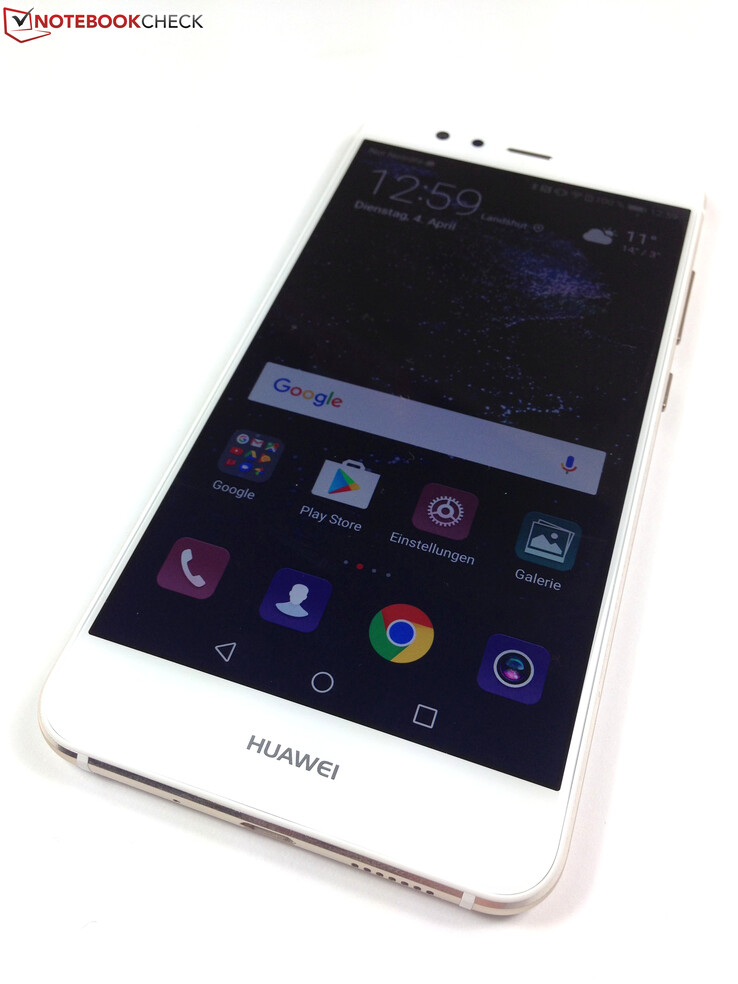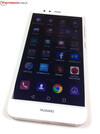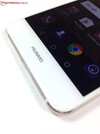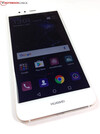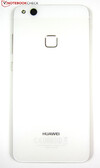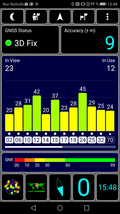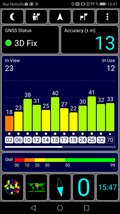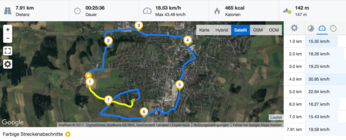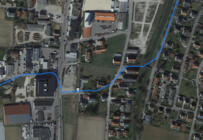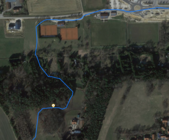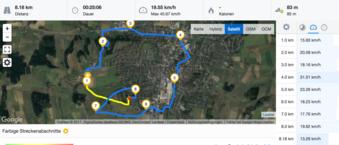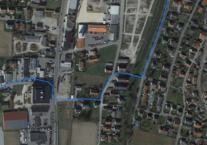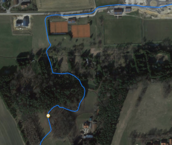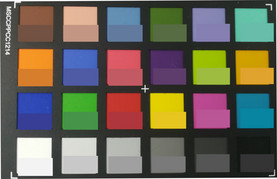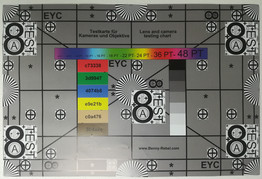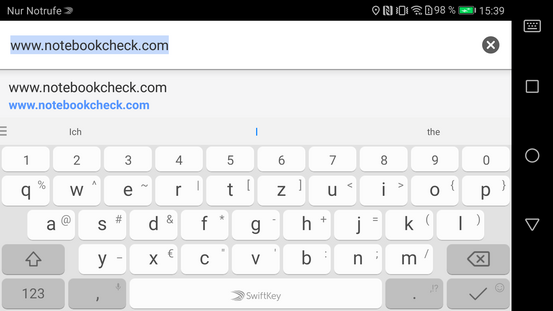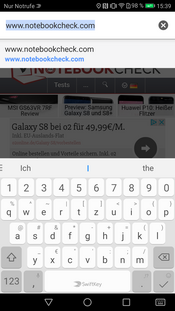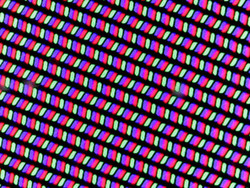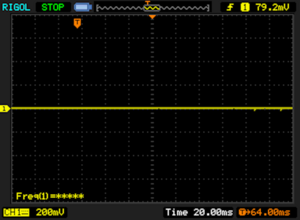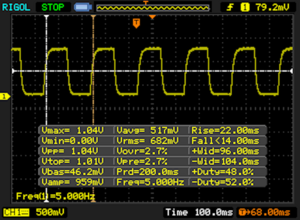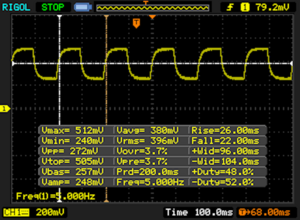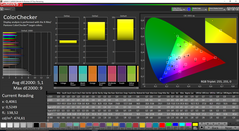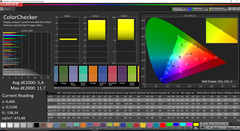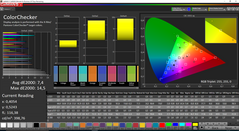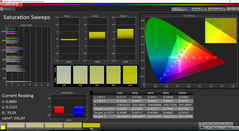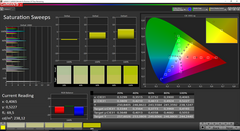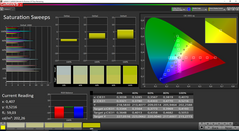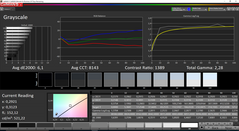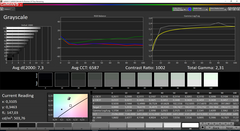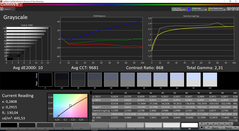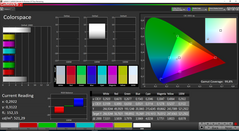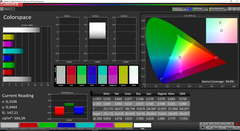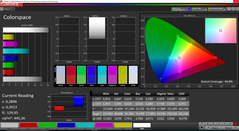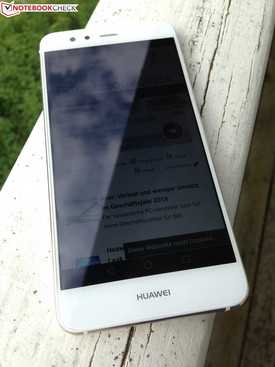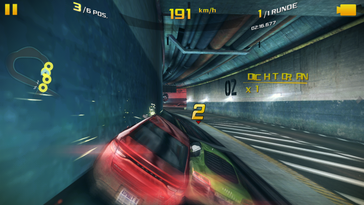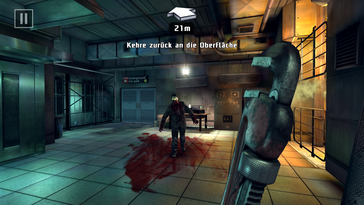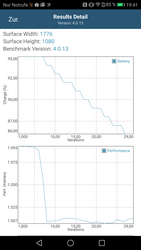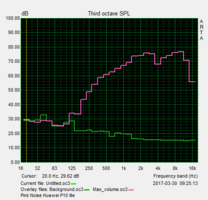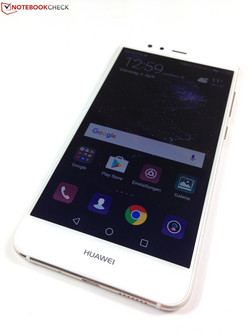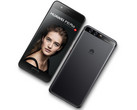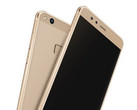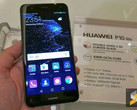Huawei P10 Lite Smartphone Review

For the original German review, see here.
With the P10 Lite, Huawei presents an affordable alternative to its high-range P10 smartphone. Instead of 600 Euros (~$636), the P10 Lite costs only around 350 Euros (~$370). Despite the price reduction, the mid-range test unit has not been slimmed down regardless of the consequences, but instead has gained slightly, that is to say, it has gained in display size. Unlike the Huawei P10 with its 5.1-inch display diagonal, the Huawei P10 Lite shows its Full HD resolution on a 5.2-inch display, without significantly differing from the P10 in height or weight. The smaller sibling can also use two SIM cards simultaneously, a feature that is even lacking in the P10. The excellent build and the current Android 7.0 Nougat operating system together with the EMUI user interface have remained the same.
As expected, the SoC power has been scaled down: instead of a HiSilicon Kirin 960, the weaker Kirin 658 labors in the Huawei P10 Lite, which however - so much has already been said - still ensures a high system performance. The Leica camera of the Huawei P10 has been omitted from the P10 Lite. As the test shows, what has been introduced instead is not a stopgap solution. With its 12-Megapixel camera, the test candidate succeeds in taking good pictures.
We let the Huawei P10 Lite compete against the similarly equipped smartphones the Honor 6X, the Huawei Nova Plus, the Lenovo Moto G4 Plus, and the Samsung Galaxy A3 (2017) that play in approximately the same price league. For comparison, the Huawei P10 is also included.
Case
Huawei offers the 5.2-inch P10 Lite in the colors Graphite Black, Sapphire Blue, Platinum Gold, and as in our test unit, Pearl White. Visually, it strongly resembles its high-end Huawei P10 colleague, even if that is slightly smaller at 5.1 inches and possesses a distinctive unique feature with its Leica dual-camera.
In terms of the build quality, both smartphones meet as equals: An aluminium chassis, rounded edges and corners, a glass covered back, practically no gaps, and a slim 7.2-millimeter (~0.28 in) thickness gives the Huawei P10 Lite an appearance and feel worthy of the high-end. The torsional strength is also very high. Although the front glass can be pressed down easily, the smartphone only reacts with a minimal amount of waves forming on the display.
The Fingerprint sensor of the Huawei P10 Lite is placed on the back and thus can be reached without any problem, even in one-handed operation. In the Huawei P10 the manufacturer pursues a different operating concept, since here the sensor is on the front.
Connectivity
The octa-core SoC and Huawei's home-grown Kirin 658 combined with 4 GB of RAM help the P10 Lite to a high system performance. Apps load quickly and there are no delays, even when many apps are running simultaneously. Thanks to the memory storage specified at 32 GB, of which 20 GB still remains available after all, many apps can be installed. The internal storage can be extended by up to 256 GB via a microSD card. However, installing apps on it will not work, since the microSD card can only be used for storage of photos and other media files.
Unfortunately, the USB port with the USB 2.0 speed and Micro-USB format supports only the basic program. The competitors such as the Huawei Nova Plus and the Samsung Galaxy A3 (2017), which bring a considerably more convenient USB Type-C port, show that one can do better in the mid-range.
The card slot of the Huawei P10 Lite functions as a hybrid slot: optionally a Nano-SIM card and a microSD card can be inserted, or you can dispense with the memory expansion and insert two SIM cards instead.
Software
The Huawei P10 Lite uses Android 7.0 Nougat with the in-house EMUI 5.1 user interface, which includes practical features such as an integrated Avast virus scanner. At the time of testing, Google's security patches were as of February 1st 2017, which is still fairly current.
Fortunately, Huawei has exercised a lot of restraint in terms of adding software. "Fortunately," because even with the few pre-installed apps, which apart from the Google apps include a handful of games and apps such as “Asphalt Nitro”, “Spider Man: Ultimate Power”, Instagram, Twitter, and TripAdvisor, the firmware already occupies around 12 GB on the smartphone, which appears to be mainly due to the EMUI and its features. However, with the exception of the Google apps, all the pre-installed apps can be uninstalled.
Communication and GPS
The Huawei P10 Lite supports GSM and UMTS Quadband as well as LTE Cat.6 with the 800, 900, 1800, 2100 and 2600 MHz frequencies that are important in the EU area. With a Nano-SIM card including the corresponding LTE data plan, downloads succeed up to 300 MBit/s and uploads up to 50 MBit/s. The smartphone can fit two SIM cards, but only if you sacrifice the microSD card slot. Moreover, you cannot use both cards simultaneously for calls and data services. In WLAN the Huawei P10 Lite communicates via the 802.11 a/b/g/n/ac standards and can use the 2.4 GHz as well as the faster 5 GHz band. To put it to the test, we evaluate the WLAN transfer speed with the Linksys EA8500 router. The Huawei P10 Lite does very well, since not only does it make good use of the available bandwidth, but also clearly surpasses the Huawei P10. The test unit receives data at 229 MBit/s and increases this to 232 MBit/s when sending. Among the competing devices, the P10 Lite is bettered only by the Samsung Galaxy A3 (2017), while the Huawei P10 does not exceed 154 MBit/s. The Huawei Nova Plus and the Honor 6X remain far behind since they are limited to the 2.4 GHz band.
| Networking | |
| iperf3 transmit AX12 | |
| Huawei P10 | |
| Huawei P10 Lite | |
| Samsung Galaxy A3 2017 | |
| Honor 6X | |
| Huawei Nova Plus | |
| iperf3 receive AX12 | |
| Huawei P10 | |
| Samsung Galaxy A3 2017 | |
| Huawei P10 Lite | |
| Honor 6X | |
| Huawei Nova Plus | |
The Huawei P10 Lite quickly finds the current location via GPS and GLONASS. In the test, the smartphone succeeds outside as well as in enclosed rooms with an accuracy of up to 9 meters (~30 ft). In our almost 8 km (~5 miles) bike route where the Huawei P10 Lite has to compete against the professional Garmin Edge 500 navigation system, it proves its practical aptitude once again. Even if it is off the trail in some parts of the route or takes some sidesteps on the way, at the end we measure a distance that is only 270 meters (~295 yd) shorter - this is quite precise for a smartphone.
Telephone and Call Quality
The Huawei P10 Lite shows a good voice quality in the test. Calling land lines as well as the Vodafone mobile network, the callers could understand each other well at all times. Dropouts or breaks in the connection did not occur. As expected, the call quality reduces slightly in hands-free speaker mode, which, however, does not give any cause for complaint.
Cameras
Unlike the Huawei P10, there is no Leica camera, but only an ordinary camera sensor in the P10 Lite. However, it still resolves to 12 Megapixel and on top of that, takes really good pictures that can definitely keep up with the images from more expensive smartphones. In the test pictures the detail and dynamic range were fitting. Colors are reproduced realistically, and even in darker areas of the scene there was hardly any noise. The 8 Megapixel webcam also succeeds in taking high quality images. As with the back camera, it can record videos in Full HD at a maximum rate of 30 pictures per second.
Huawei has adopted the extensive camera menu almost one-to-one from the Huawei P10. Here you clearly notice the influence of the professional camera manufacturer: as well as various modes for different motifs such as HDR, panorama, light-painting, and time lapse, extensive image settings are also available, which among others include smile-recognition and object-tracking that can be added. Those who like to determine the image parameters themselves can change to the Professional Photo mode, where all the important settings such as shutter speed, ISO sensitivity, and white balance can be adjusted.
To test the color fidelity of the main camera of the Huawei P10 Lite, we compare a photo of the X-Rite ColorChecker Passport taken under controlled lighting conditions with the actual reference colors. There is no post-processing of the image such as a manual white-balance correction. As the colors on the ColorChecker card show, the Huawei P10 Lite reproduces the original colors quite closely. Apart from the gray tones that are consistently not ideally matched, the smartphone achieves quite a realistic color reproduction.
To evaluate the image sharpness, we photograph our test chart under controlled artificial light. The Huawei P10 Lite reproduces it very sharp in the center of the image, but the closer we come to the edges, the more it has to struggle with problems. This should not be overrated, however, since even some professional cameras can only reproduce the test chart with frayed and blurry edges.
Accessories and Warranty
Huawei includes a Micro-USB cable, a modular power supply, and a headset. The manufacturer currently does not offer any specific accessories for their smartphone on their website.
There is a 24-month warranty on the Huawei P10 Lite. The warranty for the battery and power supply are 6 months respectively, and for the earphones it is only 3 months. Independent of that, there is off course the 24-month vendor warranty guaranteed by law on new goods. Please see our Guarantees, Return policies and Warranties FAQ for country-specific information.
Input Devices and Handling
The capacitive touchscreen of the Huawei P10 Lite recognizes up to 10 finger inputs simultaneously and completes its task exactly as expected from a good smartphone screen. While it translates inputs quickly and expeditiously, it is pleasant to the touch with its rounded edges and corners. The two physical buttons on the right side of the case feel high-quality as well. The power button and volume rocker sit inside the chassis without appreciable side-to-side play, work very precisely, and acknowledge input with a discrete click.
The fingerprint sensor works reliably and always unlocked the device on the first try in our tests. Unlike that of its larger sibling, the Huawei P10, it is now located on the back of the device, as was the case with the Huawei P9. Thus its functions, which for example, include taking calls and taking pictures and videos, can also be used comfortably when operating the smartphone with one hand. The fingerprint sensor also supports swipe and tap gestures without having to register a fingerprint. With a swipe down, the notifications can be called, with a double-tap they can be deleted, and with a swipe up the notifications can be closed again. You can comfortably flip through photos with the fingerprint sensor as well, by swiping left or right for the next or previous picture respectively.
As the first Huawei Lite smartphone, the P10 Lite now also supports the knuckle-sense technology, without introducing any new features with this, however. But operating with the knuckle is convenient regardless: a double-knock on the display takes a screenshot. Or alternatively, you can paint an "S" on the display with your knuckle to do this.
By default, the P10 Lite uses SwiftKey for its onscreen keyboard, which together with auto-correction and an additional number row overlay ensures a brisk operation. Those who do not like the layout can install another keyboard from the app store at any time.
Display
As with the display of the Huawei P10, the IPS display of the P10 Lite has a resolution of 1920x1080 pixels, but due to its larger form factor (5.2 instead of 5.1 inches) achieves only a marginally smaller pixel density (424 instead of 432 PPI). However, this does not create problems since the contents are also displayed razor-sharp on the P10 Lite, without any individual pixels being detectable.
With 509.4 cd/m² on average, the P10 Lite offers an impressive brightness. An integrated light sensor ensures that you are not blinded in darker surroundings. Although the Huawei P10 glows almost 10% brighter, it does not illuminate the screen as evenly as the P10 Lite, which achieves a top value for brightness distribution with its 95%. The P10 Lite also does slightly better with the black value (0.36 cd/m²) and in this achieves a strong contrast of 1408:1. Although the values worsen slightly (maximum brightness 484 cd/m², black value 0.37 cd/m²) when the measurements are repeated with a more even and therefore more realistic distribution of light and dark image areas (APL50), they still remain above average.
Good: In our tests we could not see any flickering caused by PWM. As in the Huawei P10, the P10 Lite also possesses a blue light filter that can be activated to protect the eyes.
| |||||||||||||||||||||||||
Brightness Distribution: 95 %
Center on Battery: 507 cd/m²
Contrast: 1408:1 (Black: 0.36 cd/m²)
ΔE ColorChecker Calman: 5.1 | ∀{0.5-29.43 Ø4.78}
ΔE Greyscale Calman: 6.1 | ∀{0.09-98 Ø5}
99.8% sRGB (Calman 2D)
Gamma: 2.28
CCT: 8143 K
| Huawei P10 Lite IPS, 1920x1080, 5.2" | Samsung Galaxy A3 2017 Super AMOLED, 1280x720, 4.7" | Honor 6X IPS, 1920x1080, 5.5" | Huawei Nova Plus IPS, 1920x1080, 5.5" | Lenovo Moto G4 Plus IPS, 1920x1080, 5.5" | Huawei P10 LTPS, 1920x1080, 5.1" | |
|---|---|---|---|---|---|---|
| Screen | 34% | -10% | -4% | 1% | 2% | |
| Brightness middle (cd/m²) | 507 | 574 13% | 547 8% | 485 -4% | 609 20% | 547 8% |
| Brightness (cd/m²) | 509 | 576 13% | 540 6% | 481 -6% | 589 16% | 556 9% |
| Brightness Distribution (%) | 95 | 94 -1% | 94 -1% | 90 -5% | 87 -8% | 86 -9% |
| Black Level * (cd/m²) | 0.36 | 0.57 -58% | 0.5 -39% | 0.63 -75% | 0.43 -19% | |
| Contrast (:1) | 1408 | 960 -32% | 970 -31% | 967 -31% | 1272 -10% | |
| Colorchecker dE 2000 * | 5.1 | 2.4 53% | 5.1 -0% | 4.2 18% | 3.8 25% | 4.8 6% |
| Colorchecker dE 2000 max. * | 9 | 3.8 58% | 9.1 -1% | 7.9 12% | 8.3 8% | 8.8 2% |
| Greyscale dE 2000 * | 6.1 | 1.9 69% | 6.2 -2% | 4.8 21% | 3.1 49% | 4.5 26% |
| Gamma | 2.28 96% | 2.09 105% | 2.09 105% | 2.36 93% | 2.06 107% | 2.39 92% |
| CCT | 8143 80% | 6502 100% | 6546 99% | 7568 86% | 6725 97% | 7194 90% |
* ... smaller is better
Screen Flickering / PWM (Pulse-Width Modulation)
| Screen flickering / PWM not detected | |||
In comparison: 53 % of all tested devices do not use PWM to dim the display. If PWM was detected, an average of 8108 (minimum: 5 - maximum: 343500) Hz was measured. | |||
Display Response Times
| ↔ Response Time Black to White | ||
|---|---|---|
| 36 ms ... rise ↗ and fall ↘ combined | ↗ 22 ms rise | |
| ↘ 14 ms fall | ||
| The screen shows slow response rates in our tests and will be unsatisfactory for gamers. In comparison, all tested devices range from 0.1 (minimum) to 240 (maximum) ms. » 93 % of all devices are better. This means that the measured response time is worse than the average of all tested devices (20.2 ms). | ||
| ↔ Response Time 50% Grey to 80% Grey | ||
| 48 ms ... rise ↗ and fall ↘ combined | ↗ 26 ms rise | |
| ↘ 22 ms fall | ||
| The screen shows slow response rates in our tests and will be unsatisfactory for gamers. In comparison, all tested devices range from 0.165 (minimum) to 636 (maximum) ms. » 82 % of all devices are better. This means that the measured response time is worse than the average of all tested devices (31.6 ms). | ||
A bright picture, strong contrast, no individual pixels detectable: Subjectively, there is nothing to complain about in the display performance of the Full HD screen. However, if we examine the screen with the Spectrophotometer and the CalMAN software a little more closely, the odd discrepancy from the norm becomes apparent. This also depends on the selected color temperature that can be determined in the display settings.
With the default "Standard" color temperature profile selection, the presentation turns out rather cool at 8143 Kelvin, which can be noticed as a slight blue tint. With the "Cool" color temperature profile, this degree of coolness can be further increased. Those who prefer a more balanced presentation need to select the color profile number three: with the "Warm" profile, the P10 Lite is practically on the ideal level (6587 Kelvin, 6500 Kelvin would be perfect) in terms of color temperature, achieving an optimal RGB balance.
With Delta-E deviations that always range between high and very high independent of the selected color temperature, reaching top values of 10 in the grayscale and 7.4 in the mixed colors (values below 3 would be ideal in both cases), we cannot speak about true-color. However, this is not very noticeable or disruptive during operation.
Because of its IPS display, the Huawei P10 scores with a design-related very high stability of the viewing angles. Even viewing from extremely wide angles, the screen contents remain clearly visible and only dim marginally at most.
The smartphone receives similarly good grades in outdoor usage due to its high brightness. If you avoid having direct sun on the display, its contents remain easily visible outside.
Performance
Although it is only a small addition to the name that differentiates the two phones, it stands for an immense performance difference: Unlike the Huawei P10 with its Kirin 960 HiSilicon SoC, the P10 Lite uses the Kirin 658 which is considerably weaker. The SoC that was only introduced in March 2017 achieves a performance that is approximately on par with a Qualcomm Snapdragon 625, which is used in the Huawei Nova Plus, for example. In the synthetic benchmarks both those phones are in a close race with the Samsung Galaxy A3 (2017) and the Honor 6X, which both fall back a bit overall. The Lenovo Moto G4 Plus comes in last, while, as expected, the Huawei P10 does not need to fear any competition since it plays in another performance league.
| AnTuTu v6 - Total Score (sort by value) | |
| Huawei P10 Lite | |
| Samsung Galaxy A3 2017 | |
| Honor 6X | |
| Huawei Nova Plus | |
| Lenovo Moto G4 Plus | |
| Huawei P10 | |
| Geekbench 4.0 | |
| 64 Bit Single-Core Score (sort by value) | |
| Huawei P10 Lite | |
| Samsung Galaxy A3 2017 | |
| Honor 6X | |
| Huawei Nova Plus | |
| Huawei P10 | |
| 64 Bit Multi-Core Score (sort by value) | |
| Huawei P10 Lite | |
| Samsung Galaxy A3 2017 | |
| Honor 6X | |
| Huawei Nova Plus | |
| Huawei P10 | |
| GFXBench (DX / GLBenchmark) 2.7 | |
| T-Rex Onscreen (sort by value) | |
| Huawei P10 Lite | |
| Samsung Galaxy A3 2017 | |
| Honor 6X | |
| Huawei Nova Plus | |
| Lenovo Moto G4 Plus | |
| Huawei P10 | |
| 1920x1080 T-Rex Offscreen (sort by value) | |
| Huawei P10 Lite | |
| Samsung Galaxy A3 2017 | |
| Honor 6X | |
| Huawei Nova Plus | |
| Lenovo Moto G4 Plus | |
| Huawei P10 | |
| GFXBench 3.0 | |
| on screen Manhattan Onscreen OGL (sort by value) | |
| Huawei P10 Lite | |
| Samsung Galaxy A3 2017 | |
| Honor 6X | |
| Huawei Nova Plus | |
| Lenovo Moto G4 Plus | |
| Huawei P10 | |
| 1920x1080 1080p Manhattan Offscreen (sort by value) | |
| Huawei P10 Lite | |
| Samsung Galaxy A3 2017 | |
| Honor 6X | |
| Huawei Nova Plus | |
| Lenovo Moto G4 Plus | |
| Huawei P10 | |
| GFXBench 3.1 | |
| on screen Manhattan ES 3.1 Onscreen (sort by value) | |
| Huawei P10 Lite | |
| Samsung Galaxy A3 2017 | |
| Honor 6X | |
| Huawei Nova Plus | |
| Lenovo Moto G4 Plus | |
| Huawei P10 | |
| 1920x1080 Manhattan ES 3.1 Offscreen (sort by value) | |
| Huawei P10 Lite | |
| Samsung Galaxy A3 2017 | |
| Honor 6X | |
| Huawei Nova Plus | |
| Lenovo Moto G4 Plus | |
| Huawei P10 | |
| PCMark for Android - Work performance score (sort by value) | |
| Huawei P10 Lite | |
| Samsung Galaxy A3 2017 | |
| Honor 6X | |
| Huawei Nova Plus | |
| Lenovo Moto G4 Plus | |
| Huawei P10 | |
In the test, the Huawei P10 Lite turns out to be a fast surfer: websites are rendered quickly and delays are the rare exception. This is also confirmed by the browser benchmarks, in which the smartphone delivers a performance on par with the Huawei Nova Plus and the Honor 6X. Although the Samsung Galaxy A3 (2017) and the Lenovo Moto G4 Plus have to shed some feathers here, they join in pretty well. For comparison, the Huawei P10 participating again, which is not surprising, is far ahead in the lead here as well.
| Octane V2 - Total Score (sort by value) | |
| Huawei P10 Lite | |
| Samsung Galaxy A3 2017 | |
| Honor 6X | |
| Huawei Nova Plus | |
| Lenovo Moto G4 Plus | |
| Huawei P10 | |
| Mozilla Kraken 1.1 - Total (sort by value) | |
| Huawei P10 Lite | |
| Samsung Galaxy A3 2017 | |
| Honor 6X | |
| Huawei Nova Plus | |
| Lenovo Moto G4 Plus | |
| Huawei P10 | |
| WebXPRT 2015 - Overall (sort by value) | |
| Huawei P10 Lite | |
| Samsung Galaxy A3 2017 | |
| Honor 6X | |
| Huawei Nova Plus | |
| Lenovo Moto G4 Plus | |
| Huawei P10 | |
| JetStream 1.1 - Total Score (sort by value) | |
| Huawei P10 Lite | |
| Samsung Galaxy A3 2017 | |
| Honor 6X | |
| Huawei Nova Plus | |
| Lenovo Moto G4 Plus | |
| Huawei P10 | |
* ... smaller is better
The Huawei P10 Lite sets a brisk pace reading and writing data. The smartphone manages sequential data transfers in particular in a shorter time than the entire mid-range competition that is running against it. How reading and writing is done in the upper league, the Huawei P10 shows with its extremely fast UFS-2.1 storage. However, none of the smartphones can get up to the top rates of the Toshiba Exceria Pro M401 reference microSD card (read up 95 MB/s, write up to 80 MB/s). The Samsung Galaxy A3 (2017) and the Lenovo Moto G4 Plus fare best in this.
| Huawei P10 Lite | Samsung Galaxy A3 2017 | Honor 6X | Huawei Nova Plus | Lenovo Moto G4 Plus | Huawei P10 | |
|---|---|---|---|---|---|---|
| AndroBench 3-5 | -19% | 9% | -10% | 9% | 174% | |
| Sequential Read 256KB (MB/s) | 264.3 | 199.7 -24% | 283.4 7% | 241.6 -9% | 271.4 3% | 738 179% |
| Sequential Write 256KB (MB/s) | 129.2 | 45.96 -64% | 73.8 -43% | 82.1 -36% | 43.48 -66% | 189.8 47% |
| Random Read 4KB (MB/s) | 72.5 | 22.32 -69% | 39.55 -45% | 35.64 -51% | 36.32 -50% | 168.4 132% |
| Random Write 4KB (MB/s) | 19.36 | 9.62 -50% | 45.05 133% | 30.12 56% | 35.79 85% | 152.3 687% |
| Sequential Read 256KB SDCard (MB/s) | 53.4 | 75.5 41% | 52 -3% | 41.64 -22% | 74.4 39% | 54.2 1% |
| Sequential Write 256KB SDCard (MB/s) | 32.7 | 50.1 53% | 34.53 6% | 33.32 2% | 46.92 43% | 32.19 -2% |
Games
Equipped with the mid-range ARM Mali-T830 MP1 graphics accelerator, the Huawei P10 Lite brings enough computing power to render the current Android games smoothly to a large extent. “Dead Trigger 2” is such a case: even with maximum graphic detail, we measure a butter-smooth 52 images per second on average. But the test runs with “Asphalt 8: Airborne” show that it does not always run smoothly. The race game that is very demanding on the graphics, stutters considerably with 22 images per second at the maximum graphics detail. However, if you turn down the eye-candy level, the frame rates increase to a smooth 30 images per second; due to an internal limitation in this game, a higher frame rate is not possible anyway.
The hardware does what it is supposed to do: the position sensor works without a hitch and the touchscreen translates the input precisely. If you hold the Huawei P10 Lite in landscape format, it can happen easily that you accidentally cover the speaker located at the foot of the device.
| Asphalt 8: Airborne | |||
| Settings | Value | ||
| high | 22 fps | ||
| very low | 30 fps | ||
| Dead Trigger 2 | |||
| Settings | Value | ||
| high | 51 fps | ||
Emissions
Temperature
Bearing down on the Huawei P10 Lite with an hour-long stress test, it still only heats up to a maximum of 35 °C (~95 °F) in this (unrealistic) test scenario, remaining in temperature ranges that give absolutely no reason for concern. During everyday app usage and gaming, you might feel a slight warming at most that would hardly reach the maximum of the stress test.
As the GFXBench battery test that renders the "T-Rex" game scene 30 times in a row shows, because of the low operating temperature of the SoC, performance is also not throttled. Although the performance slows down slightly after around the eighth run, this change is so small that we cannot speak about throttling.
(+) The maximum temperature on the upper side is 34.9 °C / 95 F, compared to the average of 35.2 °C / 95 F, ranging from 21.9 to 247 °C for the class Smartphone.
(+) The bottom heats up to a maximum of 35 °C / 95 F, compared to the average of 34 °C / 93 F
(+) In idle usage, the average temperature for the upper side is 31.2 °C / 88 F, compared to the device average of 32.9 °C / 91 F.
Speaker
Even though the mono speaker of the Huawei P10 is not for the true audiophile, it does its work surprisingly well. At 85 dB(A) the sound membrane can become quite loud and does not distort even at the maximum level. But we cannot really talk about listening pleasure, since the sound reproduction is very sharp and makes listening strenuous in the long run. On mid-level volumes, the speaker sounds much better. Then the mids and highs presented are very balanced and overall produce a sound image that is remarkably good. The sound impression is again much better when using the included earphones.
Huawei P10 Lite audio analysis
(+) | speakers can play relatively loud (85 dB)
Bass 100 - 315 Hz
(-) | nearly no bass - on average 27.2% lower than median
(±) | linearity of bass is average (10.3% delta to prev. frequency)
Mids 400 - 2000 Hz
(+) | balanced mids - only 4.6% away from median
(+) | mids are linear (5.1% delta to prev. frequency)
Highs 2 - 16 kHz
(±) | higher highs - on average 6.8% higher than median
(+) | highs are linear (5.2% delta to prev. frequency)
Overall 100 - 16.000 Hz
(±) | linearity of overall sound is average (23.4% difference to median)
Compared to same class
» 52% of all tested devices in this class were better, 8% similar, 40% worse
» The best had a delta of 11%, average was 35%, worst was 134%
Compared to all devices tested
» 69% of all tested devices were better, 6% similar, 25% worse
» The best had a delta of 4%, average was 24%, worst was 134%
Samsung Galaxy A3 2017 audio analysis
(+) | speakers can play relatively loud (82.6 dB)
Bass 100 - 315 Hz
(-) | nearly no bass - on average 19.2% lower than median
(±) | linearity of bass is average (9.7% delta to prev. frequency)
Mids 400 - 2000 Hz
(±) | higher mids - on average 8.7% higher than median
(±) | linearity of mids is average (7.4% delta to prev. frequency)
Highs 2 - 16 kHz
(±) | higher highs - on average 5.6% higher than median
(+) | highs are linear (6.9% delta to prev. frequency)
Overall 100 - 16.000 Hz
(±) | linearity of overall sound is average (26.1% difference to median)
Compared to same class
» 66% of all tested devices in this class were better, 6% similar, 28% worse
» The best had a delta of 11%, average was 35%, worst was 134%
Compared to all devices tested
» 80% of all tested devices were better, 4% similar, 16% worse
» The best had a delta of 4%, average was 24%, worst was 134%
Honor 6X audio analysis
(±) | speaker loudness is average but good (81.9 dB)
Bass 100 - 315 Hz
(-) | nearly no bass - on average 21.7% lower than median
(±) | linearity of bass is average (10.2% delta to prev. frequency)
Mids 400 - 2000 Hz
(±) | higher mids - on average 8.4% higher than median
(±) | linearity of mids is average (7.8% delta to prev. frequency)
Highs 2 - 16 kHz
(±) | higher highs - on average 6.7% higher than median
(+) | highs are linear (5.8% delta to prev. frequency)
Overall 100 - 16.000 Hz
(±) | linearity of overall sound is average (29.1% difference to median)
Compared to same class
» 76% of all tested devices in this class were better, 3% similar, 21% worse
» The best had a delta of 11%, average was 35%, worst was 134%
Compared to all devices tested
» 87% of all tested devices were better, 2% similar, 11% worse
» The best had a delta of 4%, average was 24%, worst was 134%
Frequency diagram in comparison (checkboxes above can be checked and unchecked!)
Energy Management
Power Consumption
The Huawei P10 Lite gets its power from a 3000 mAh Lithium-Polymer battery that cannot be removed. Its power consumption could best be described with the attribute "unremarkable": Compared with the competition, it is neither particularly high (maximum 4.9 watts) nor particularly low, but just within the plain average – which need not be a disadvantage. A look at the power consumption of the competitors shows that with its runtime, the Huawei P10 Lite will not reach the level of the runtime specialists such as the Samsung Galaxy A3 (2017), but on the other hand will easily beat the power-hungry Huawei P10.
| Off / Standby | |
| Idle | |
| Load |
|
Key:
min: | |
| Huawei P10 Lite 3000 mAh | Samsung Galaxy A3 2017 2350 mAh | Honor 6X 3340 mAh | Huawei Nova Plus 3340 mAh | Lenovo Moto G4 Plus 3000 mAh | |
|---|---|---|---|---|---|
| Power Consumption | 44% | -23% | 2% | -30% | |
| Idle Minimum * (Watt) | 0.38 | 0.37 3% | 0.82 -116% | 0.49 -29% | 0.63 -66% |
| Idle Average * (Watt) | 1.87 | 0.78 58% | 2 -7% | 1.63 13% | 1.91 -2% |
| Idle Maximum * (Watt) | 1.92 | 0.84 56% | 2.03 -6% | 1.76 8% | 1.96 -2% |
| Load Average * (Watt) | 3.82 | 1.52 60% | 3.34 13% | 2.98 22% | 3.88 -2% |
| Load Maximum * (Watt) | 4.9 | 2.75 44% | 4.92 -0% | 4.99 -2% | 8.74 -78% |
* ... smaller is better
Runtime
With 11:05 hours while surfing and almost 10 hours while playing the H.264 test video, the Huawei P10 Lite achieves good battery runtimes, even if they are not phenomenal. With the exception of the Lenovo Moto G4 Plus, which is overall as enduring as the test unit, led by the Samsung Galaxy A3 (2017) and the Honor 6X, all the other candidates come out better than the P10 Lite.
In the in-house competition with the Huawei P10, the P10 Lite just barely loses. Though the power consumption of the larger sibling is considerably higher at times, that is only the case when the SoC is really challenged, such as during gaming or in the last scenario where the app stability test was run. If there are everyday tasks such as web surfing, the Huawei P10 has the edge due to its larger battery. The short charging time, however, speaks for the P10 Lite: it takes barely 2 hours to charge the battery from 0 to the 100% level in our test.
| Huawei P10 Lite 3000 mAh | Samsung Galaxy A3 2017 2350 mAh | Honor 6X 3340 mAh | Huawei Nova Plus 3340 mAh | Lenovo Moto G4 Plus 3000 mAh | Huawei P10 3200 mAh | |
|---|---|---|---|---|---|---|
| Battery runtime | 64% | 47% | 30% | 0% | 3% | |
| Reader / Idle (h) | 23.5 | 47.7 103% | 37.5 60% | 34.1 45% | 20.4 -13% | 25.7 9% |
| H.264 (h) | 9.8 | 16.5 68% | 14.8 51% | 12.2 24% | 12.9 32% | 9.7 -1% |
| WiFi v1.3 (h) | 11.1 | 11.1 0% | 16 44% | 13.7 23% | 12.3 11% | 16.1 45% |
| Load (h) | 4.8 | 8.9 85% | 6.3 31% | 6.1 27% | 3.4 -29% | 2.9 -40% |
Pros
Cons
Verdict
Huawei did not promise too much: The P10 Lite is a real alternative to the expensive, almost 600-Euro (~$636), P10. As with its high-end relative, the mid-range convinces with an excellent build, which makes it look significantly more expensive than one would imagine considering its current street price of around 350 Euros (~$371) at the time of testing. Though the P10 Lite does not have the Leica camera of the Huawei P10, a 12-Megapixel camera that scores with a surprisingly high image quality proves to be a worthy alternative.
We also liked the bright display and features such as the fast WLAN, LTE Cat.6, as well as the option to operate two SIM cards in the smartphone, even though one has to give up the microSD slot for it. The battery runtimes are reasonable and should last the user through a complete day without any problems.
If it does not have to be an extra fast processor and Leica camera optics as in the Huawei P10, it is worth taking a look at the Huawei P10 Lite. At 350 Euros (~$371), the mid-range 5.2-inch smartphone offers the most affordable entry into the P10 product series.
Huawei has saved on the USB-2.0 port, which with its older Micro-USB connector instead of Type-C, invites playing the jolly "oh, I got it upside down" game. Unfortunately, apps cannot be installed on the microSD card - a shame, considering the particularly extensive firmware that reduces the 32 GB storage to a mere 20 GB. At least almost all the pre-installed apps can be cleaned off the smartphone to free some storage. There is almost nothing wrong with the SoC performance. "Almost" since when you use the Huawei P10 Lite for gaming, the graphic details possibly have to be reduced for the display to keep running smoothly.
Huawei P10 Lite
- 04/12/2017 v6 (old)
Manuel Masiero




